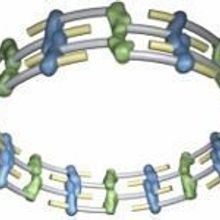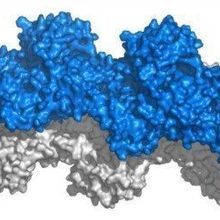Login
Subscribeprotein structure

Now AI Can Be Used to Design New Proteins
Kamal Nahas, PhD | Mar 3, 2023 | 4 min read
Machine learning can be harnessed to synthesize artificial light-bearing enzymes that actually work in cells.

Scientists Resurrect Ancient Rubiscos to Understand Their Evolution
Alejandra Manjarrez, PhD | Oct 14, 2022 | 5 min read
A team proposes that the addition of a small accessory subunit to the carbon-fixing enzyme was key to improving its catalytic properties and specificity to CO2.

Technique Talk: The Fundamentals of Mass Spectrometry-Based Proteomics
The Scientist | 1 min read
Learn the basics of proteomics analysis and nanoLC-MS/MS data acquisition.

2023 Breakthrough Prizes Showcase Research in AI and Narcolepsy
Amanda Heidt | Sep 22, 2022 | 2 min read
Three prizes were awarded to six researchers working across the life sciences on cellular organization, protein structure, and the genetic underpinnings of a chronic sleep disorder.

Infographic: Short Protein Motifs’ Role in SARS-CoV-2 Infection
Conchita Fraguas Bringas and Jakob Nilsson | May 16, 2022 | 4 min read
Known as SLiMs, these stretches of up to 10 amino acids play notable roles in cell biology, including responses to viral invasion.

An Introductory Guide to Proteomics
Sejal Davla, PhD | 5 min read
Deconstructing concepts, approaches, and data analysis in proteomics workflows.

Spike Structure Gives Insight into SARS-CoV-2 Evolution
Abby Olena, PhD | Jul 16, 2020 | 3 min read
Researchers demonstrate that the SARS-CoV-2 spike protein is more stable and binds the human ACE2 receptor with much higher affinity than the spike protein of its closest known relative, bat coronavirus RaTG13.

Crowdsourced Protein Simulation Exceeds Supercomputers’ Power
Shawna Williams | Apr 15, 2020 | 2 min read
Folding@Home, currently focused on deciphering the workings of SARS-CoV-2, is the first project to have exascale-level computational muscle.

Probing Antibody Binding to the SARS-CoV-2 Spike Protein
The Scientist Creative Services Team in collaboration with Refeyn | 2 min read
Victor Yin will discuss two single-particle mass analysis methods that shed light on heterogenous, multimeric proteins and their interactions.

Nobel-Winning Biochemist Paul Boyer Dies
Shawna Williams | Jun 7, 2018 | 2 min read
The UCLA researcher was lauded for figuring out how ATP synthase works.

Unknown Protein Structures Predicted
Ruth Williams | Jan 19, 2017 | 3 min read
Metagenomic sequence data boosts the power of protein modeling software to yield hundreds of new protein structure predictions.

Understanding the Complexity of Cancer with Cryo-EM
The Scientist and Thermo Fisher Scientific | 1 min read
Explore how researchers use cryogenic electron microscopy (cryo-EM) to identify how mutations affect protein signaling and function through structural or conformational changes.

Video: Inner Circle
The Scientist | Nov 30, 2016 | 1 min read
See an animation that illustrates emerging insights into the inner ring structures of the nuclear pore complex.

Fraudulent Paper Pulled
Bob Grant | Jan 5, 2016 | 1 min read
Nature retracts a study six years after an investigation found that the protein structures it reported were fabricated.

Focus on Structure to Verify Protein Function
The Scientist and RedShift Bio | 1 min read
Scientists analyze a therapeutic protein’s secondary structure to confirm drug efficacy and safety.

Getting Back in Shape
Karen Zusi | Dec 1, 2015 | 3 min read
Contrary to years of research suggesting otherwise, most aggregated proteins regain their shape and functionality following heat shock.

Cas9 Proofreads Gene Edits
Karen Zusi | Nov 13, 2015 | 2 min read
The gene-editing CRISPR/Cas9 system has three checkpoints to ensure it alters the right section of DNA.

Using Nanopores to Sense and Sequence Proteins
The Scientist | 1 min read
Aleksei Aksimentiev and Stefan Howorka discuss challenges in amino acid sensing with nanopores and approaches to design efficient protein sequencing technology.

The Handedness of Cells
Kerry Grens | Jun 17, 2015 | 1 min read
Actin—the bones of the cell—has a preference for swirling into a counterclockwise pattern.
